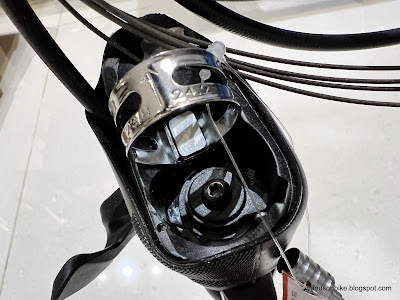The Campagnolo Ekar shifters is one of the few gravel specific shifters available in the market. The only other gravel specific shifters that I know of are the Shimano GRX RX815 (Di2) which I am using on the Cervelo Aspero, and the GRX RX810/600/400 mechanical road shifters.
This shifter is unique because it is a 13 speed shifter, with a front single setup. In other words, there is a shifting mechanism for 13 speeds in the right shifter, and no shifting mechanism at all in the left shifter. Both shifters use hydraulic braking for maximum braking performance.
Let's take a closer look, and compare it to the Shimano 105 R7020 mechanical shifter (which is similar to the GRX mechanical road shifters).
Shifters come with the hydraulic brake calipers as a set.
Comes with a special pin that is supposed to be inserted into the shifters to lock the lever.
Shifter outer casing is included. The yellow bleed block is combined with the pad spacer.
Right side shifter with hose, oil and shifter inner cable is 305 grams. For comparison, the Dura-Ace R9120 is 265 grams without oil or hose, so the Ekar shifters are pretty competitive in weight.
Left side shifter has no shifting mechanism, so it is very light at just 238 grams with hose and oil.
End of hose has a special insert that allows you to use an inner cable cast head to pull the hose through the internal routing of the frame. Clever design!
Rubber hood of the Ekar shifters look awful to me. It has an glossy texture that looks cheap and nasty, although it is not actually oily.
Campagnolo shifters have a shifting lever behind the brake lever for inward shifting, and a release lever on the bracket body for outward shifting.
Traditionally, the release lever can only be operated by the thumb when holding the top of the hoods.
The new C-shaped release lever allows it to be operated by the thumb even when the rider is holding the drops.
Shifting mechanism is completely exposed at the back of the bracket. That said, it will be sealed against the handlebar when assembled.
Small hole on the brake lever for lever reach adjustment.
On the left shifter, there is no shifting mechanism as it is a front single system.
Hydraulic hose is connected to the master cylinder with a banjo bolt, similar to what is seen on the SRAM Rival AXS shifters. Note the waffle pattern on the inside of the rubber hood which provides a cushioning effect for the hand.
As always, I am interested to do comparisons with other components. On hand, what I have is the Shimano 105 R7020 11 speed mechanical shifter with hydraulic braking. Check out the pictures below to see the similarities and differences.
Campagnolo Ekar vs Shimano 105 R7020. Ekar has a shorter bracket with a smaller hood, and a curvier brake lever.
Shimano uses the brake lever as a shifting lever as well, while Ekar has 3 levers for 3 separate functions.
Ekar hood and brake lever is narrower. I prefer the wider Shimano brake lever.
Ekar shifter has an inward curve which makes it more comfortable when using the aero hoods position. Similar to the new Shimano Di2 road shifters, such as Ultegra R8170.
Shimano brake lever is straight, while the Ekar shifter has a pronounced curve.
In terms of ergonomics, the smaller bracket and inward curve of the Ekar shifters feel better, but I prefer the wider and flatter brake lever of the Shimano shifters. Shifting wise, the Shimano levers are easier to use, as compared to the stiff and clunky release lever on the Ekar shifter.
Apart from the ergonomics and mechanism difference, the hydraulic small parts are different as well. More specifically, the Connecting Insert and Olive are different in design.
Shimano Connecting Insert and Olive for BH90 hose.
Campagnolo Connecting Insert and Olive.
Shimano Olive on left, Campagnolo Olive on right. Different shape with unknown cross compatibility.
Campagnolo Olive seems to be thicker, with a slightly larger diameter?
Shimano Connecting Insert (for BH90 hose) in silver on the left, Campagnolo Connecting Insert in gold on the right. Length difference is obvious.
Shimano Connecting Insert tapers to a thin wall, while the Campagnolo Connecting Insert has a thicker wall even at the tip.
Big chamfer but smaller internal diameter on the gold Campagnolo Connecting Insert.
I found a table that compares the differences in Connecting Insert and Olive, but the Campagnolo type is not found here.
There are some online sources that say the Campagnolo Connecting Insert and Olive design is the same as Magura, but the table shows otherwise. Not sure which is correct, as I found it impossible to find aftermarket Campagnolo Connecting Insert and Olive.
In the next post, I will share more information on the Campagnolo Ekar brake calipers and rotors.




























That isn't a Campagnolo olive and barb. They use Magura style connectors. It looks like you are comparing Shimano BH-90 and BH-59.
ReplyDelete